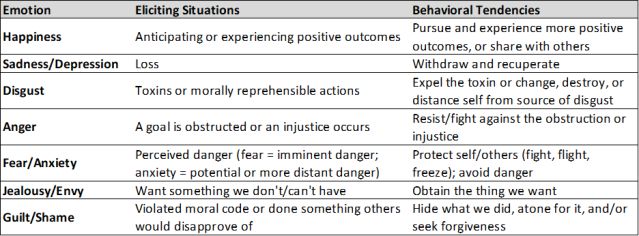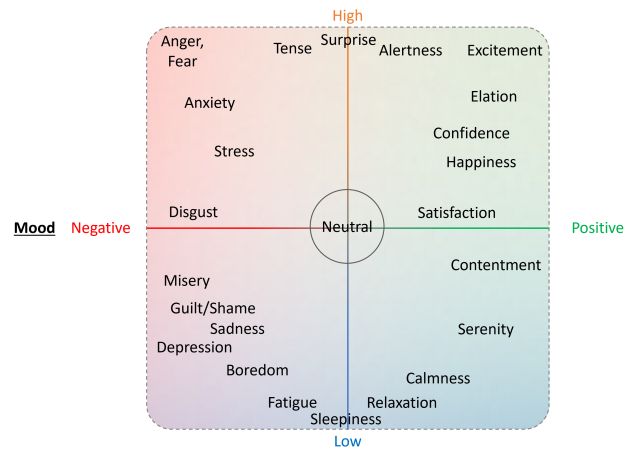All emotions have specific situations that elicit them and specific actions that they motivate us to perform (Linehan, 2015). In fact, the word “emotion” has the word “motion” in it, and its Latin root is “emoveo,” which means to move out of (Wiktionary, 2023). The DBT Skills Training Manual nicely describes the eliciting situations and behavioral tendencies of a variety of emotions (Linehan, 2015).

See Table 1 for a summary of several emotions. Specifically, happiness occurs when we anticipate or experience positive outcomes, and it motivates us to pursue and experience more positive outcomes (or share them with others). Sadness and depression occur when we lose something important to us (a job or a loved one), and they motivate us to withdraw and recuperate. Disgust occurs in response to toxins or morally reprehensible actions, and it makes us want to expel the toxins (which is why the facial expression for disgust is opening the mouth like we’re going to vomit) or to change, destroy, or distance ourselves from the source of disgust.
Anger occurs when a goal is obstructed or an injustice is experienced, and it motivates us to resist or fight the obstruction (to obtain the goal) or right the injustice. Fear and anxiety occur when we perceive danger (imminent danger for fear and possible future danger for anxiety), and they motivate us to protect ourselves (flee if we can, freeze or hide to avoid detection, and fight as a last resort to deter the threat; Perusini & Fanselow, 2015).
Jealousy and envy occur when we want something we don’t have or can’t have, but jealousy occurs when that “something” is socially intimate (e.g., someone you are romantically interested in is flirting with someone else), and envy occurs when that “something” is material or related to social status (e.g., someone has a car you want; someone gets chosen for a desirable work project instead of you). Jealousy and envy both motivate us to obtain the things we want.
Guilt and shame are also similar to each other; they occur when we have violated our moral code (guilt) or when we have done something we think others will disapprove of (shame). They motivate us to hide what we did, atone for what we did, and/or seek forgiveness.
The above descriptions view emotions as distinct categories, each having different functions (Ekman, 1992). Instead of being viewed as different categories, emotions can also be viewed along three dimensions: mood, energy, and power (Bradley & Lang, 1994; Colibazzi et al., 2010; Islam et al., 2021; Posner, Russell, & Peterson, 2005; Russell, 1980; Tseng et al., 2014). Both perspectives are valid.
Another approach to understanding emotions
Let’s start with two of those dimensions: mood and energy (Figure 1). From left to right on the X-axis, we have mood—this represents emotions that feel negative, neutral, or positive. On the Y-axis, we have energy—this represents how energized we feel by our emotions. From bottom to top, we have emotions that have low, medium, or high energy.

Where does the emotion “satisfaction” belong on this graph? It is a moderately positive, moderate-energy emotion, so it will be in the middle-right portion of the graph. How about fear? That is a highly negative, high-energy emotion, so it belongs in the top-left corner. How about anger? That is also a highly negative, high-energy emotion, so it also belongs in the top-left corner.
Both anger and fear are in the top-left corner of the graph, but they seem qualitatively different. Fear is about defending yourself from perceived danger, whereas anger is about fighting against injustice or things that prevent us from obtaining our goals. So, how do we distinguish them using this graph? We need a third axis—the Z-axis—going toward us and away from us (not shown in the figure due to visual complexity). This is the power axis, where on one end, we have emotions where we feel dominant, and at the other end, we have emotions where we feel submissive.
Fear is a highly negative, high-energy, submissive emotion—when we are fearful, we often feel like the threat is more powerful than us. Anger is a highly negative, high-energy, dominant emotion—when we are angry, we often feel like (or imagine that) we are more powerful than what we are fighting against. Excitement is a highly positive emotion, high-energy, and dominant emotion. Every emotion belongs somewhere on this three-dimensional graph.
What are some common emotions you experience? Where do they belong on the graph? If you haven’t already, feel free to take a moment to explore the locations of various emotions in Figure 1.
So, what do we do with this information?
Using the categorical perspective of emotions, we can understand which situations elicit specific emotions and which behaviors those emotions motivate us to engage in. Whether we are interested in this for ourselves, our friends and family, or our children, it can be very helpful to think about a given situation, observe the behaviors, and infer the emotions accurately. This helps build our emotional and social intelligence, tells us what is really happening in that situation, and helps us determine how we respond to those situations—including how to communicate with others.
There are various techniques from clinical psychology that can be applied in these everyday situations, such as compassion, validation, relaxation, problem-solving, exposure (i.e., facing your fears), behavioral activation (doing activities—usually positive ones), and many others. For example, by accurately understanding that a person is jealous (as opposed to anxious, angry, or sad), you could validate that person’s experiences, empathize with them, communicate with them effectively, and potentially help them decide how to best proceed in that situation (if they are interested in problem-solving—oftentimes, people just want validation and empathy).
Similarly, by understanding the three-dimensional model of emotions, we know that changing energy from high to low (or vice versa) can change emotions. For example, if a person is very excited—perhaps too excited for a specific situation—then conducting some relaxation exercises might reduce energy levels. This could shift them from “excited” to “happy” or “content,” which might be more appropriate in that situation. The same goes for changing the other dimensions—changing them can change the emotions.
Overall, emotions are deeply embedded in the human experience. Understanding and regulating emotions is a foundational life skill that can help us live our best lives and enhance our relationships with others. It is sometimes difficult to understand emotions in challenging situations. In those cases, psychologists can help you understand the inner workings of yourself or those around you so that you can live your life to the fullest.
